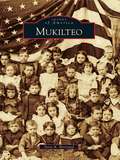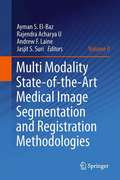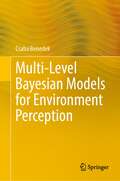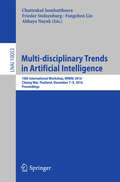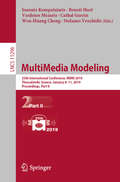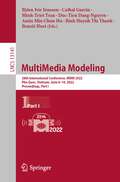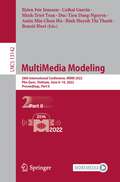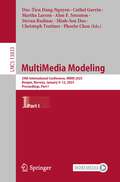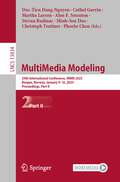- Table View
- List View
Mukilteo (Images of America)
by Steve K. BertrandLocated on the waters of Possession Sound, Mukilteo is one of the earliest settlements in Snohomish County. It takes its name, which means "good camping ground," from the Native American people who established a permanent winter village on the spit of land and adjoining salt marsh. Numerous events add to Mukilteo's rich history, including the visit of Capt. George Vancouver in 1792 and Gov. Isaac Stevens's signing of the Point Elliott Treaty in 1855. Founded by Morris Frost and Jacob Fowler in 1860, the city housed the first salmon cannery in Washington and one of the region's earliest breweries. Japanese immigrants became an important part of the community from 1903 to 1930 while working for the Crown Lumber Company. The city's lighthouse, located near the Mukilteo-Clinton ferry dock, has been a well-known fixture since 1906.
Mulata Nation: Visualizing Race and Gender in Cuba (Caribbean Studies Series)
by Alison FraunharRepeatedly and powerfully throughout Cuban history, the mulata, a woman of mixed racial identity, features prominently in Cuban visual and performative culture. Tracing the figure, Alison Fraunhar looks at the representation and performance in both elite and popular culture. She also tracks how characteristics associated with these women have accrued across the Atlantic world.Widely understood to embody the bridge between European subject and African other, the mulata contains the sensuality attributed to Africans in a body more closely resembling the European ideal of beauty. This symbol bears far-reaching implications, with shifting, contradictory cultural meanings in Cuba. Fraunhar explores these complex paradigms, how, why, and for whom the image was useful, and how it was both subverted and asserted from the colonial period to the present. From the early seventeenth century through Cuban independence in 1899 up to the late revolutionary era, Fraunhar illustrates the ambiguous figure's role in nationhood, citizenship, and commercialism. She analyzes images including key examples of nineteenth-century graphic arts, avant-garde painting and magazine covers of the Republican era, cabaret and film performance, and contemporary iterations of gender.Fraunhar's study stands out for attending to the phenomenon of mulataje not only in elite production such as painting, but also in popular forms: popular theater, print culture, later films, and other media where stereotypes take hold. Indeed, in contemporary Cuba, mulataje remains a popular theme with Cubans as well as foreigners in drag shows, reflecting queerness in visual culture.
Multi Modality State-of-the-Art Medical Image Segmentation and Registration Methodologies. Volume 1
by Jasjit S. Suri Majid Mirmehdi Ayman S. El-Baz Rajendra Acharya UWith the advances in image guided surgery for cancer treatment, the role of image segmentation and registration has become very critical. The central engine of any image guided surgery product is its ability to quantify the organ or segment the organ whether it is a magnetic resonance imaging (MRI) and computed tomography (CT), X-ray, PET, SPECT, Ultrasound, and Molecular imaging modality. Sophisticated segmentation algorithms can help the physicians delineate better the anatomical structures present in the input images, enhance the accuracy of medical diagnosis and facilitate the best treatment planning system designs. The focus of this book in towards the state of the art techniques in the area of image segmentation and registration.
Multi Modality State-of-the-Art Medical Image Segmentation and Registration Methodologies: Volume II
by Jasjit S. Suri Ayman S. El-Baz Rajendra Acharya U Andrew F. LaineWith the advances in image guided surgery for cancer treatment, the role of image segmentation and registration has become very critical. The central engine of any image guided surgery product is its ability to quantify the organ or segment the organ whether it is a magnetic resonance imaging (MRI) and computed tomography (CT), X-ray, PET, SPECT, Ultrasound, and Molecular imaging modality. Sophisticated segmentation algorithms can help the physicians delineate better the anatomical structures present in the input images, enhance the accuracy of medical diagnosis and facilitate the best treatment planning system designs. The focus of this book in towards the state of the art techniques in the area of image segmentation and registration.
Multi-Level Bayesian Models for Environment Perception
by Csaba BenedekThis book deals with selected problems of machine perception, using various 2D and 3D imaging sensors. It proposes several new original methods, and also provides a detailed state-of-the-art overview of existing techniques for automated, multi-level interpretation of the observed static or dynamic environment. To ensure a sound theoretical basis of the new models, the surveys and algorithmic developments are performed in well-established Bayesian frameworks. Low level scene understanding functions are formulated as various image segmentation problems, where the advantages of probabilistic inference techniques such as Markov Random Fields (MRF) or Mixed Markov Models are considered. For the object level scene analysis, the book mainly relies on the literature of Marked Point Process (MPP) approaches, which consider strong geometric and prior interaction constraints in object population modeling. In particular, key developments are introduced in the spatial hierarchical decomposition of the observed scenarios, and in the temporal extension of complex MRF and MPP models. Apart from utilizing conventional optical sensors, case studies are provided on passive radar (ISAR) and Lidar-based Bayesian environment perception tasks. It is shown, via several experiments, that the proposed contributions embedded into a strict mathematical toolkit can significantly improve the results in real world 2D/3D test images and videos, for applications in video surveillance, smart city monitoring, autonomous driving, remote sensing, and optical industrial inspection.
Multi-Modality Imaging: Applications and Computational Techniques
by Mauren Abreu de Souza Humberto Remigio Gamba Helio PedriniThis book presents different approaches on multi-modality imaging with a focus on biomedical applications. Medical imaging can be divided into two categories: functional (related to physiological body measurements) and anatomical (structural) imaging modalities.In particular, this book covers imaging combinations coming from the usual popular modalities (such as the anatomical modalities, e.g. X-ray, CT and MRI), and it also includes some promising and new imaging modalities that are still being developed and improved (such as infrared thermography (IRT) and photoplethysmography imaging (PPGI)), implying potential approaches for innovative biomedical applications.Moreover, this book includes a variety of tools on computer vision, imaging processing, and computer graphics, which led to the generation and visualization of 3D models, making the most recent advances in this area possible. This is an ideal book for students and biomedical engineering researchers covering the biomedical imaging field.
Multi-Platform Graphics Programming with Kivy: Basic Analytical Programming for 2D, 3D, and Stereoscopic Design
by Moisés Cywiak David CywiakModern science requires computer graphics models to provide realistic visual renderings. Learning the appropriate programming tools for 2D and 3D modeling doesn’t have to be so difficult. This book reviews the best programming tools to achieve this and explains how to apply them to mobile platforms like Android. Multi-Platform Graphics Programming with Kivy provides a straightforward introductory approach for designing 2D, 3D, and stereoscopic applications, using analytical equations from vector algebra. Throughout the book you’ll look closely at this approach and develop scenes in Kivy, taking advantage of powerful mathematical functions for arrays by NumPy for Python. Unbuntu is used to develop the programs, which allows you to easily convert to Android platform. Each chapter contains step-by-step descriptions on each subject and provides complete program listings.What You’ll LearnWork with Kivy, a modern, powerful multi-platform graphics systemConvert and run programs on Android devicesProgram, fill faces, and rotate 2D and 3D polygonsApply the concepts of 2D and 3D applicationsDevelop stereoscopic scenesReview a straightforward introduction to 2D, 3D, and stereoscopic graphics applicationsUse simple analytical equations from vector algebraWho This Book Is ForThe primary audience is students and researchers in graphics programming with experience in analytical equations.
Multi-Unit Housing in Urban Cities: From 1800 to Present Day
by Katy Chey<p>This book investigates the development of multi-unit housing typologies that were predominant in a particular city from the 1800s to present day. It emphasises the importance of understanding the direct connection between housing and dwelling in the context of a city, and the manner in which the city is an instructional indication of how a housing typology is embodied. <p>The case studies presented offer an insight into why a certain housing type flourished in a specific city and the variety span across cities in the world where distinct housing types have prevailed. It also pursues how housing types developed, evolved, and helped define the city, looks into how dwellers inhabited their dwellings, and analyses how the housing typologies correlates in a contemporary context. The typologies studied are back-to-backs in Birmingham; tenements in London; Haussmann Apartment in Paris; tenements in New York; tong lau in Hong Kong; perimeter block, linear block, and block-edge in Berlin; perimeter block and solitaire in Amsterdam; space-enclosing structure in Beijing; micro house in Tokyo, and high-rise in Toronto.</p>
Multi-disciplinary Trends in Artificial Intelligence: 10th International Workshop, MIWAI 2016, Chiang Mai, Thailand, December 7-9, 2016, Proceedings (Lecture Notes in Computer Science #10053)
by Chattrakul Sombattheera, Frieder Stolzenburg, Fangzhen Lin and Abhaya NayakThis book constitutes the refereed conference proceedings of the 10th International Conference on Multi-disciplinary Trends in Artificial Intelligence, MIWAI 2016, held in Chiang Mai, Thailand, in December 2016. The 22 revised full papers presented together with 5 short papers and 2 abstracts of invited talks were carefully reviewed and selected from 50 submissions. The workshop solicits papers from all areas of AI including cognitive science; computational intelligence; computational philosophy; game theory; machine learning; multi-agent systems; natural language; representation and reasoning; speech; vision and the web; as well as applications of AI in big data; bioinformatics; biometrics; decision support; e-commerce; image processing; analysis and retrieval; industrial applications; knowledge management; privacy; recommender systems; security; software engineering; spam filtering; surveillance; telecommunications; and web services.
Multi-disciplinary Trends in Artificial Intelligence: 13th International Conference, MIWAI 2019, Kuala Lumpur, Malaysia, November 17–19, 2019, Proceedings (Lecture Notes in Computer Science #11909)
by Kok Wai Wong Rapeeporn ChamchongThis book constitutes the refereed proceedings of the 13th International Conference on Multi-disciplinary Trends in Artificial Intelligence, MIWAI 2019, held in Kuala Lumpur, Malaysia, in November 2019.The 19 full papers and 6 short papers presented were carefully reviewed and selected from 53 submissions. They cover a wide range of topics in theory, methods, and tools in AI sub-areas such as cognitive science, computational philosophy, computational intelligence, game theory, machine learning, multi-agent systems, natural language, representation and reasoning, data mining, speech, computer vision and the Web as well as their applications in big data, bioinformatics, biometrics, decision support, knowledge management, privacy, recommender systems, security, software engineering, spam filtering, surveillance, telecommunications, Web services, and IoT.
Multi-disciplinary Trends in Artificial Intelligence: 14th International Conference, MIWAI 2021, Virtual Event, July 2–3, 2021, Proceedings (Lecture Notes in Computer Science #12832)
by Junmo Kim Phatthanaphong Chomphuwiset Pornntiwa PawaraThis book constitutes the refereed proceedings of the 14th International Conference on Multi-disciplinary Trends in Artificial Intelligence, MIWAI 2021, held online in July 2021.The 13 full papers and 3 short papers presented were carefully reviewed and selected from 33 submissions. They cover a wide range of topics in theory, methods, and tools in AI sub-areas such as cognitive science, computational philosophy, computational intelligence, game theory, machine learning, multi-agent systems, natural language, representation and reasoning, data mining, speech, computer vision and the Web as well as their applications in big data, bioinformatics, biometrics, decision support, knowledge management, privacy, recommender systems, security, software engineering, spam filtering, surveillance, telecommunications, Web services, and IoT.
Multi-faceted Deep Learning: Models and Data
by Jenny Benois-Pineau Akka ZemmariThis book covers a large set of methods in the field of Artificial Intelligence - Deep Learning applied to real-world problems. The fundamentals of the Deep Learning approach and different types of Deep Neural Networks (DNNs) are first summarized in this book, which offers a comprehensive preamble for further problem–oriented chapters. The most interesting and open problems of machine learning in the framework of Deep Learning are discussed in this book and solutions are proposed. This book illustrates how to implement the zero-shot learning with Deep Neural Network Classifiers, which require a large amount of training data. The lack of annotated training data naturally pushes the researchers to implement low supervision algorithms. Metric learning is a long-term research but in the framework of Deep Learning approaches, it gets freshness and originality. Fine-grained classification with a low inter-class variability is a difficult problem for any classification tasks. This book presents how it is solved, by using different modalities and attention mechanisms in 3D convolutional networks. Researchers focused on Machine Learning, Deep learning, Multimedia and Computer Vision will want to buy this book. Advanced level students studying computer science within these topic areas will also find this book useful.
Multi-media: Video – Installation – Performance
by Nick KayeMulti-media charts the development of multi-media video, installation and performance in a unique dialogue between theoretical analysis and specially commissioned documentations by some of the world’s foremost artists. Nick Kaye explores the interdisciplinary history and character of experimental practices shaped in exchanges between music, installation, theatre, performance art, conceptual art, sculpture and video. The book sets out key themes and concerns in multi-media practice, addressing time, space, the resurgence of ephemerality, liveness and ‘aura’. These chapters are interspersed with documentary artwork and essays by artists whose work continues to shape the field, including new articles from: Vito Acconci The Builders Association John Jesurun Pipilotti Rist Fiona Templeton. Multi-media also reintroduces a major documentary essay by Paolo Rosa of Studio Azzurro in a new, fully illustrated form. This book combines sophisticated scholarly analysis and fascinating original work to present a refreshing and creative investigation of current multi-media arts practice.
Multi-purpose High-rise Towers and Tall Buildings
by H. R. Viswanath J.J.A. Tolloczko J. N. ClarkeInterest continues to develop in the design and construction of high-rise towers and tall buildings, structures with heights ranging from 75m to 500m and even more. This volume presents the papers from the third in a series of international conferences on the subject, organised by the International Federation of High-rise Structures. The papers hav
Multi-risk Interactions Towards Resilient and Sustainable Cities (Advances in Sustainability Science and Technology)
by Tiago Miguel FerreiraFor years, researchers have studied the risks of individual natural hazards in urban areas. However, the impact of multiple hazards has not yet received widespread attention in research and urban management practice, which is a significant gap in the current climate change context. This book aims to contribute to filling that gap by examining the process of identifying, assessing, and managing multi-hazard risks in urban areas. From identifying and assessing the vulnerability of the elements exposed to the impact of natural hazards, including earthquakes, floods, fires, and landslides, this book covers all the critical stages of multi-hazard risk assessment and management in a climate change context. The concepts and approaches discussed in the book are applied to the Lisbon Metropolitan Area, a dynamic and thriving metropolis, allowing readers to see those theories applied in a real setting. In addition to providing a solid theoretical foundation, this book offers practical guidelines for conducting risk assessment at the metropolitan scale, which makes it a valuable resource for researchers, practitioners, and decision-makers interested in understanding and managing multi-hazard risks in urban areas.
Multi-sensor Fusion for Autonomous Driving
by Jun Li Li Wang Huaping Liu Mo Zhou Zhiwei Li Xinyu Zhang Zhenhong ZouAlthough sensor fusion is an essential prerequisite for autonomous driving, it entails a number of challenges and potential risks. For example, the commonly used deep fusion networks are lacking in interpretability and robustness. To address these fundamental issues, this book introduces the mechanism of deep fusion models from the perspective of uncertainty and models the initial risks in order to create a robust fusion architecture. This book reviews the multi-sensor data fusion methods applied in autonomous driving, and the main body is divided into three parts: Basic, Method, and Advance. Starting from the mechanism of data fusion, it comprehensively reviews the development of automatic perception technology and data fusion technology, and gives a comprehensive overview of various perception tasks based on multimodal data fusion. The book then proposes a series of innovative algorithms for various autonomous driving perception tasks, to effectively improve the accuracy and robustness of autonomous driving-related tasks, and provide ideas for solving the challenges in multi-sensor fusion methods. Furthermore, to transition from technical research to intelligent connected collaboration applications, it proposes a series of exploratory contents such as practical fusion datasets, vehicle-road collaboration, and fusion mechanisms. In contrast to the existing literature on data fusion and autonomous driving, this book focuses more on the deep fusion method for perception-related tasks, emphasizes the theoretical explanation of the fusion method, and fully considers the relevant scenarios in engineering practice. Helping readers acquire an in-depth understanding of fusion methods and theories in autonomous driving, it can be used as a textbook for graduate students and scholars in related fields or as a reference guide for engineers who wish to apply deep fusion methods.
MultiMedia Modeling: 25th International Conference, MMM 2019, Thessaloniki, Greece, January 8–11, 2019, Proceedings, Part I (Lecture Notes in Computer Science #11295)
by Benoit Huet Stefanos Vrochidis Cathal Gurrin Ioannis Kompatsiaris Vasileios Mezaris Wen-Huang ChengThe two-volume set LNCS 11295 and 11296 constitutes the thoroughly refereed proceedings of the 25th International Conference on MultiMedia Modeling, MMM 2019, held in Thessaloniki, Greece, in January 2019.Of the 172 submitted full papers, 49 were selected for oral presentation and 47 for poster presentation; in addition, 6 demonstration papers, 5 industry papers, 6 workshop papers, and 6 papers for the Video Browser Showdown 2019 were accepted. All papers presented were carefully reviewed and selected from 204 submissions.
MultiMedia Modeling: 25th International Conference, MMM 2019, Thessaloniki, Greece, January 8–11, 2019, Proceedings, Part II (Lecture Notes in Computer Science #11296)
by Benoit Huet Stefanos Vrochidis Cathal Gurrin Ioannis Kompatsiaris Vasileios Mezaris Wen-Huang ChengThe two-volume set LNCS 11295 and 11296 constitutes the thoroughly refereed proceedings of the 25th International Conference on MultiMedia Modeling, MMM 2019, held in Thessaloniki, Greece, in January 2019. Of the 172 submitted full papers, 49 were selected for oral presentation and 47 for poster presentation; in addition, 6 demonstration papers, 5 industry papers, 6 workshop papers, and 6 papers for the Video Browser Showdown 2019 were accepted. All papers presented were carefully reviewed and selected from 204 submissions.
MultiMedia Modeling: 26th International Conference, MMM 2020, Daejeon, South Korea, January 5–8, 2020, Proceedings, Part I (Lecture Notes in Computer Science #11961)
by Jung-Woo Choi Junmo Kim Wen-Huang Cheng Wei-Ta Chu Peng Cui Min-Chun Hu Wesley De NeveThe two-volume set LNCS 11961 and 11962 constitutes the thoroughly refereed proceedings of the 25th International Conference on MultiMedia Modeling, MMM 2020, held in Daejeon, South Korea, in January 2020. Of the 171 submitted full research papers, 40 papers were selected for oral presentation and 46 for poster presentation; 28 special session papers were selected for oral presentation and 8 for poster presentation; in addition, 9 demonstration papers and 6 papers for the Video Browser Showdown 2020 were accepted. The papers of LNCS 11961 are organized in the following topical sections: audio and signal processing; coding and HVS; color processing and art; detection and classification; face; image processing; learning and knowledge representation; video processing; poster papers; the papers of LNCS 11962 are organized in the following topical sections: poster papers; AI-powered 3D vision; multimedia analytics: perspectives, tools and applications; multimedia datasets for repeatable experimentation; multi-modal affective computing of large-scale multimedia data; multimedia and multimodal analytics in the medical domain and pervasive environments; intelligent multimedia security; demo papers; and VBS papers.
MultiMedia Modeling: 26th International Conference, MMM 2020, Daejeon, South Korea, January 5–8, 2020, Proceedings, Part II (Lecture Notes in Computer Science #11962)
by Jung-Woo Choi Junmo Kim Wen-Huang Cheng Wei-Ta Chu Peng Cui Min-Chun Hu Wesley De NeveThe two-volume set LNCS 11961 and 11962 constitutes the thoroughly refereed proceedings of the 25th International Conference on MultiMedia Modeling, MMM 2020, held in Daejeon, South Korea, in January 2020. Of the 171 submitted full research papers, 40 papers were selected for oral presentation and 46 for poster presentation; 28 special session papers were selected for oral presentation and 8 for poster presentation; in addition, 9 demonstration papers and 6 papers for the Video Browser Showdown 2020 were accepted. The papers of LNCS 11961 are organized in the following topical sections: audio and signal processing; coding and HVS; color processing and art; detection and classification; face; image processing; learning and knowledge representation; video processing; poster papers; the papers of LNCS 11962 are organized in the following topical sections: poster papers; AI-powered 3D vision; multimedia analytics: perspectives, tools and applications; multimedia datasets for repeatable experimentation; multi-modal affective computing of large-scale multimedia data; multimedia and multimodal analytics in the medical domain and pervasive environments; intelligent multimedia security; demo papers; and VBS papers.
MultiMedia Modeling: 27th International Conference, MMM 2021, Prague, Czech Republic, June 22–24, 2021, Proceedings, Part I (Lecture Notes in Computer Science #12572)
by Stefanos Vrochidis Klaus Schoeffmann Vasileios Mezaris Jakub Lokoč Tomáš Skopal Xirong Li Ioannis PatrasThe two-volume set LNCS 12572 and 1273 constitutes the thoroughly refereed proceedings of the 27th International Conference on MultiMedia Modeling, MMM 2021, held in Prague, Czech Republic, in June2021. Of the 211 submitted regular papers, 40 papers were selected for oral presentation and 33 for poster presentation; 16 special session papers were accepted as well as 2 papers for a demo presentation and 17 papers for participation at the Video Browser Showdown 2021. The papers cover topics such as: multimedia indexing; multimedia mining; multimedia abstraction and summarization; multimedia annotation, tagging and recommendation; multimodal analysis for retrieval applications; semantic analysis of multimedia and contextual data; multimedia fusion methods; multimedia hyperlinking; media content browsing and retrieval tools; media representation and algorithms; audio, image, video processing, coding and compression; multimedia sensors and interaction modes; multimedia privacy, security and content protection; multimedia standards and related issues; advances in multimedia networking and streaming; multimedia databases, content delivery and transport; wireless and mobile multimedia networking; multi-camera and multi-view systems; augmented and virtual reality, virtual environments; real-time and interactive multimedia applications; mobile multimedia applications; multimedia web applications; multimedia authoring and personalization; interactive multimedia and interfaces; sensor networks; social and educational multimedia applications; and emerging trends.
MultiMedia Modeling: 28th International Conference, MMM 2022, Phu Quoc, Vietnam, June 6–10, 2022, Proceedings, Part I (Lecture Notes in Computer Science #13141)
by Benoit Huet Cathal Gurrin Björn Þór Jónsson Minh-Triet Tran Duc-Tien Dang-Nguyen Anita Min-Chun Hu Binh Huynh Thi ThanhThe two-volume set LNCS 13141 and LNCS 13142 constitutes the proceedings of the 28th International Conference on MultiMedia Modeling, MMM 2022, which took place in Phu Quoc, Vietnam, during June 6–10, 2022.The 107 papers presented in these proceedings were carefully reviewed and selected from a total of 212 submissions. They focus on topics related to multimedia content analysis; multimedia signal processing and communications; and multimedia applications and services.
MultiMedia Modeling: 28th International Conference, MMM 2022, Phu Quoc, Vietnam, June 6–10, 2022, Proceedings, Part II (Lecture Notes in Computer Science #13142)
by Benoit Huet Cathal Gurrin Björn Þór Jónsson Minh-Triet Tran Duc-Tien Dang-Nguyen Anita Min-Chun Hu Binh Huynh Thi ThanhThe two-volume set LNCS 13141 and LNCS 13142 constitutes the proceedings of the 28th International Conference on MultiMedia Modeling, MMM 2022, which took place in Phu Quoc, Vietnam, during June 6–10, 2022.The 107 papers presented in these proceedings were carefully reviewed and selected from a total of 212 submissions. They focus on topics related to multimedia content analysis; multimedia signal processing and communications; and multimedia applications and services.
MultiMedia Modeling: 29th International Conference, MMM 2023, Bergen, Norway, January 9–12, 2023, Proceedings, Part I (Lecture Notes in Computer Science #13833)
by Christoph Trattner Alan F. Smeaton Cathal Gurrin Duc-Tien Dang-Nguyen Phoebe Chen Martha Larson Stevan Rudinac Minh-Son DaoThe two-volume set LNCS 13833 and LNCS 13834 constitutes the proceedings of the 29th International Conference on MultiMedia Modeling, MMM 2023, which took place in Bergen, Norway, during January 9-12, 2023. The 86 papers presented in these proceedings were carefully reviewed and selected from a total of 267 submissions. They focus on topics related to multimedia content analysis; multimedia signal processing and communications; and multimedia applications and services.
MultiMedia Modeling: 29th International Conference, MMM 2023, Bergen, Norway, January 9–12, 2023, Proceedings, Part II (Lecture Notes in Computer Science #13834)
by Christoph Trattner Alan F. Smeaton Cathal Gurrin Duc-Tien Dang-Nguyen Phoebe Chen Martha Larson Stevan Rudinac Minh-Son DaoThe two-volume set LNCS 13833 and LNCS 13834 constitutes the proceedings of the 29th International Conference on MultiMedia Modeling, MMM 2023, which took place in Bergen, Norway, during January 9-12, 2023. The 86 papers presented in these proceedings were carefully reviewed and selected from a total of 267 submissions. They focus on topics related to multimedia content analysis; multimedia signal processing and communications; and multimedia applications and services.
